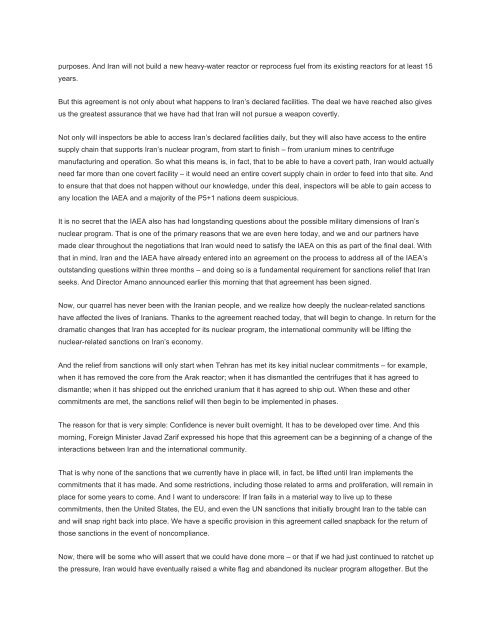WHAT YOU NEED TO KNOW ABOUT THE JCPOA
jcpoa_what_you_need_to_know
jcpoa_what_you_need_to_know
You also want an ePaper? Increase the reach of your titles
YUMPU automatically turns print PDFs into web optimized ePapers that Google loves.
purposes. And Iran will not build a new heavy-water reactor or reprocess fuel from its existing reactors for at least 15years.But this agreement is not only about what happens to Iran’s declared facilities. The deal we have reached also givesus the greatest assurance that we have had that Iran will not pursue a weapon covertly.Not only will inspectors be able to access Iran’s declared facilities daily, but they will also have access to the entiresupply chain that supports Iran’s nuclear program, from start to finish – from uranium mines to centrifugemanufacturing and operation. So what this means is, in fact, that to be able to have a covert path, Iran would actuallyneed far more than one covert facility – it would need an entire covert supply chain in order to feed into that site. Andto ensure that that does not happen without our knowledge, under this deal, inspectors will be able to gain access toany location the IAEA and a majority of the P5+1 nations deem suspicious.It is no secret that the IAEA also has had longstanding questions about the possible military dimensions of Iran’snuclear program. That is one of the primary reasons that we are even here today, and we and our partners havemade clear throughout the negotiations that Iran would need to satisfy the IAEA on this as part of the final deal. Withthat in mind, Iran and the IAEA have already entered into an agreement on the process to address all of the IAEA’soutstanding questions within three months – and doing so is a fundamental requirement for sanctions relief that Iranseeks. And Director Amano announced earlier this morning that that agreement has been signed.Now, our quarrel has never been with the Iranian people, and we realize how deeply the nuclear-related sanctionshave affected the lives of Iranians. Thanks to the agreement reached today, that will begin to change. In return for thedramatic changes that Iran has accepted for its nuclear program, the international community will be lifting thenuclear-related sanctions on Iran’s economy.And the relief from sanctions will only start when Tehran has met its key initial nuclear commitments – for example,when it has removed the core from the Arak reactor; when it has dismantled the centrifuges that it has agreed todismantle; when it has shipped out the enriched uranium that it has agreed to ship out. When these and othercommitments are met, the sanctions relief will then begin to be implemented in phases.The reason for that is very simple: Confidence is never built overnight. It has to be developed over time. And thismorning, Foreign Minister Javad Zarif expressed his hope that this agreement can be a beginning of a change of theinteractions between Iran and the international community.That is why none of the sanctions that we currently have in place will, in fact, be lifted until Iran implements thecommitments that it has made. And some restrictions, including those related to arms and proliferation, will remain inplace for some years to come. And I want to underscore: If Iran fails in a material way to live up to thesecommitments, then the United States, the EU, and even the UN sanctions that initially brought Iran to the table canand will snap right back into place. We have a specific provision in this agreement called snapback for the return ofthose sanctions in the event of noncompliance.Now, there will be some who will assert that we could have done more – or that if we had just continued to ratchet upthe pressure, Iran would have eventually raised a white flag and abandoned its nuclear program altogether. But the


